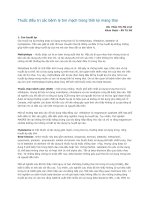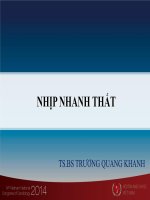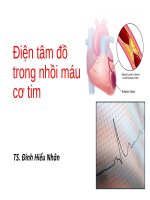Điện tâm đồ trong các bệnh lý tim bẩm sinh về cấu trúc
Bạn đang xem bản rút gọn của tài liệu. Xem và tải ngay bản đầy đủ của tài liệu tại đây (2.39 MB, 36 trang )
ECG IN CONGENITAL
HEART DISEASES
Dr TRẦN CÔNG BẢO PHỤNG, CHILDREN HOSPITAL N1
• ECG IN COMMON CONGENITAL HEART DISEASES
• ARRYTHMIAS AFTER OPEN HEART SURGERIES
ASD
Small ASD: normal ECG
Large ASD : RAD, RAH,
RVH±RBBB or 1st degree AV block
VSD
.
Small VSD, ECG is normal.
Moderate VSD: LVH and occasional left LAH.
Large defect: BVH with or without LAH.
If pulmonary vascular obstructive disease
develops, the ECG shows RVH only.
VSD
Large vsd / 3 months baby: LVH, RVH
PDA
Similar to those in VSD.
A normal ECG or LVH with small to
moderate PDA.
BVH with large PDA.
If pulmonary vascular obstructive
disease develops, RVH is present.
TOF
1. Right axis deviation (RAD)
(+120 to +150 degrees).
2. RVH. BVH in the acyanotic
form. RAH is occasionally
present.
EBSTEIN
1. RBBB and RAH
2. First-degree AV block in 40% of
patients. A WPW pattern in 15% to
20% of patients with occasional
episodes of SVT.
EBSTEIN
Tracing from a 5-year-old child with Ebstein's anomaly. The tracing shows right atrial
hypertrophy, right bundle branch block, and first-degree atrioventricular block
PS
Mild: normal ECG.
Moderate PS: Right axis deviation (RAD) and
RVH. The degree of RVH on the ECG correlates
with the severity of PS.
Neonates with critical PS may show LVH because
of a hypoplastic RV and relatively large LV
PAIVS
The QRS axis is normal (i.e., +60 to +140
degrees), in contrast to the superiorly
oriented QRS axis seen in tricuspid atresia.
LVH. Occasionally, RVH is seen in infants
with a relatively large RV cavity. RAH
DORV
Subaortic VSD without PS: resembles ECDc.
Superior QRS axis. RVH or BVH, LAH. 1st
degree AV block.
Subaortic VSD with pulmonary stenosis
(Fallot type): RAD, RAH, RVH, or RBBB.
1st degree AV block
Subpulmonary VSD (Taussig-Bing
syndrome): RAD, RAH, and RVH. LVH:
during infancy
AVSD
“Superior” QRS axis with the QRS axis
between -40 and -150 degrees is
characteristic of the defect .
Most of the patients have a prolonged PR
interval (first-degree AV block).
RVH or RBBB is present in all cases, and
many patients have LVH.
AVSD
Tracing from a 5-year-old boy with Down syndrome and complete atrioventricular canal. Note the
“superior” QRS axis (-110 degrees) and right ventricular hypertrophy
TGA
Rightward QRS axis ( +90 to +200 degrees).
RVH is usually present after the first few days
of life.
Biventricular hypertrophy (BVH) with large
VSD, PDA, or PAH.
Occasionally RAH.
TGA
ECG tracing from a 6-day-old male infant with complete transposition of the great arteries. The
QRS axis is +140 degrees. Note the deep S waves in V5 and V6 and an upright T wave in V1.
ALCAPA
Anterolateral myocardial infarction
pattern: abnormally deep and wide Q
waves, inverted T waves, and an STsegment shift in leads I and aVL and
the precordial leads
Early postoperative arrhythmias
Hemodynamically significant arrhythmias are frequent in the early days after
pediatric cardiac surgery, affecting perhaps 15–20% of cases overall
•
•
•
•
Sinus tachycardia
Junctional ectopic tachycardia
Atrial tachycardia and atrial flutter
Sinus bradycardia
•
•
•
•
Ventricular premature beats
ventricular tachycardia
Ventricular fibrillation
Postoperative complete AV
block
Sinus tachycardia
Junctional ectopic tachycardia
Adenosin reveal JET
3 years old boy after double switch for L TGA: atrial flutter
Neonate after TAPVC repair: PAC recovered with oral propanolol
Ventricular tachycardia in 5 year old girl after RVO conduit replacement
Complete AV block in 18 months old girl after resection of severve fibromuscular subaortic stenosis
Late postoperative arrhythmias
The main arrhythmias of concern are incisional atrial tachycardia (atrial
flutter), sinoatrial disease, and ventricular tachycardia
• Arrhythmias after the Senning and Mustard operations
• Arrhythmias after repair of a tetralogy of Fallot
• Arrhythmias after the Fontan operation
Arrhythmias after the Senning and Mustard operations
Sinus bradycardia
Atrial flutter









